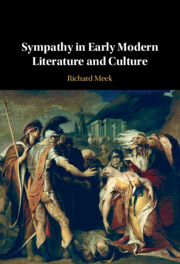Book contents
- Sympathy in Early Modern Literature and Culture
- Sympathy in Early Modern Literature and Culture
- Copyright page
- Contents
- Figures
- Acknowledgements
- Note on Texts
- Introduction
- Chapter 1 ‘A sympathy of affections’
- Chapter 2 ‘Compassion and mercie draw teares from the godlyfull often’
- Chapter 3 ‘Grief best is pleased with grief’s society’
- Chapter 4 ‘O, what a sympathy of woe is this’
- Chapter 5 ‘Soveraignes have a sympathie with subjects’
- Chapter 6 ‘As God loves Sympathy, God loves Symphony’
- Coda
- Bibliography
- Index
Chapter 2 - ‘Compassion and mercie draw teares from the godlyfull often’
The Rhetoric of Sympathy in the Early Modern Sermon
Published online by Cambridge University Press: 27 April 2023
- Sympathy in Early Modern Literature and Culture
- Sympathy in Early Modern Literature and Culture
- Copyright page
- Contents
- Figures
- Acknowledgements
- Note on Texts
- Introduction
- Chapter 1 ‘A sympathy of affections’
- Chapter 2 ‘Compassion and mercie draw teares from the godlyfull often’
- Chapter 3 ‘Grief best is pleased with grief’s society’
- Chapter 4 ‘O, what a sympathy of woe is this’
- Chapter 5 ‘Soveraignes have a sympathie with subjects’
- Chapter 6 ‘As God loves Sympathy, God loves Symphony’
- Coda
- Bibliography
- Index
Summary
This chapter examines the important cultural role played by early modern sermons in refining and developing the meaning of sympathy. The chapter begins by exploring how metaphors and concepts involving the human and social body were appropriated by religious writers in the 1580s, including Edwin Sandys, John Udall, and Christopher Hooke. It then explores a particular sermon by William James from 1589 that uses the term sympathy to describe a mutual suffering, in which James seeks to unite his listeners whilst excluding those of a different religious or political persuasion. The chapter goes on to argue that, by the mid-1590s, preachers such as Henry Holland were using the term to describe an active and imaginative engagement with the other, in ways that recall several contemporaneous dramatic works – including Shakespeare’s Romeo and Juliet (c. 1595). Finally, it examines Thomas Wright’s The Passions of the Minde in Generall (1604) and proposes that these questions about the performance and representation of sympathy recur across Protestant and Catholic cultures.
- Type
- Chapter
- Information
- Sympathy in Early Modern Literature and Culture , pp. 72 - 102Publisher: Cambridge University PressPrint publication year: 2023



